In both tabletop role-playing and computer games where players choose between different characters, some characters may be stronger than others when played optimally. This is undesirable in multiplayer games, because either most players will choose the stronger characters or some players will be handicapped by their weak character, which tends to reduce the enjoyment. Game designers spend time and resources “balancing” the game, i.e. changing aspects of the characters to give them all approximately equal strength. It is difficult to predict all possible ways a character may be played, so players may discover tricks that make a character significantly stronger than others. To counteract this, the game can be made self-balancing: the more players choose a given character, the weaker that character becomes. Then the discovery of ways to play a character better (giving additional strength) initially benefits the discoverer, but is neutralised with widespread imitation, analogously to innovative firms reaping monopoly profits initially from their patents, but eventually losing their competitive advantage to imitators.
The simplest way to self-balance is to subtract some measure of strength, e.g. health points, armor, attack points from the most frequently chosen characters. One in-game interpretation of this loss of strength to crowding is that each character channels power from some source (magic item, god, nature) and if more people channel a given source, then each of them gets less power. There are other ways to impose a negative congestion externality to achieve self-balancing.
One source of congestion-induced weakening is that in-game enemies (NPCs) fight better against characters they frequently encounter. This can be interpreted as learning (if the enemies flee before dying and later come back) or evolution (if the longer-surviving enemies multiply relatively more). In an evolutionary arms race, players pick characters that are strong against frequently encountered NPCs. NPCs vary in their resistance to different attacks and relatively more copies are spawned of those who last the longest under player attack.
Another congestion externality is a shortage of some resource that strengthens a particular class of characters. For example, equipment usable by that class may be in limited supply, in which case if many players choose that class, then they will find themselves under-equipped and weak. There could also be a shortage of materials for manufacturing the equipment, or a shortage of class-specific quests for gaining experience.
To make players (as opposed to NPCs or the game mechanics) the source of disadvantage to a frequently chosen class, the classes should have advantages over each other in a cycle, for example archers defeat riders, riders defeat swordfighters, swords defeat archers. In this case, if a class is frequently chosen, then this invites other players to choose another class that has an advantage over the frequent class, e.g. if many have chosen riders, then this creates an incentive to choose archers. Such a cyclical evolutionary dynamic has been observed in lizards (Rapid Temporal Reversal in Predator-Driven Natural Selection, Science 17 Nov 2006 Vol. 314, Issue 5802, pp. 1111).
